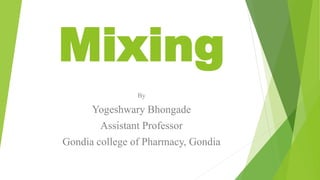The document discusses mixing processes in pharmaceutical applications, detailing objectives, mechanisms, and types of mixers including propellers, turbines, and paddle mixers. It explains various mixing techniques, categories of mixtures, factors affecting mixing efficiency, and applications in producing emulsions and powders. Additionally, it highlights the construction, working principles, advantages, and disadvantages of different mixing equipment.































































